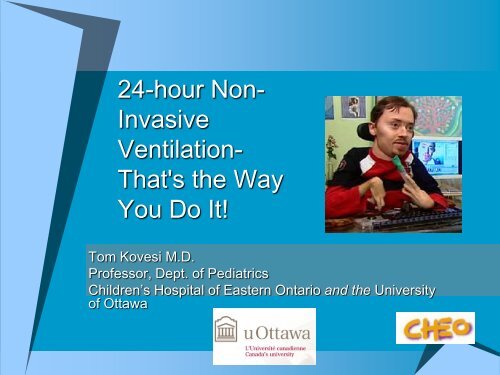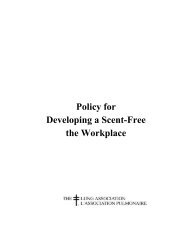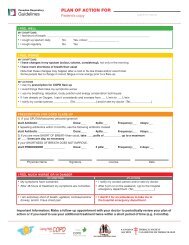24-hour Non- Invasive Ventilation - Canadian Lung Association
24-hour Non- Invasive Ventilation - Canadian Lung Association
24-hour Non- Invasive Ventilation - Canadian Lung Association
You also want an ePaper? Increase the reach of your titles
YUMPU automatically turns print PDFs into web optimized ePapers that Google loves.
<strong>24</strong>-<strong>hour</strong> <strong>Non</strong>-<br />
<strong>Invasive</strong><br />
<strong>Ventilation</strong>-<br />
That's the Way<br />
You Do It!<br />
Tom Kovesi M.D.<br />
Professor, Dept. of Pediatrics<br />
Children’s Hospital of Eastern Ontario and the University<br />
of Ottawa
Disclosures<br />
<strong>Non</strong>e.
Respiratory Function in Duchenne<br />
Muscular Dystrophy<br />
In adolescence, Vital Capacity falls 8-12%/year<br />
Nighttime hypercapnia likely once FVC < 40%<br />
predicted (1 L) & progresses to daytime<br />
hypercapnia within 12 mos in 70%<br />
< 30% pred. - high risk nocturnal hypoventilation<br />
(needs sleep study!) (Katz, ADC 2004)<br />
Daytime hypercapnia likely with FVC < 20%<br />
predicted (300-400 mL)<br />
Ventilator-free time < 15 minutes once FVC < 10%<br />
predicted*<br />
*Toussaint, Thorax 2008; Toussaint, Chronic Resp Dis 2007
Survival in Duchenne Muscular<br />
Dystrophy<br />
Mean survival (untreated) 19 - 21 years<br />
Survival about 1 year (untreated) once FVC < 1 L<br />
Nighttime BiPAP delays daytime hypercapnia by 4-5<br />
yrs and extends survival by 5-10 years<br />
Nighttime BiPAP + Daytime ventilation can extend<br />
survival beyond 31 yrs of age*<br />
With Deflazacort, natural history is totally different:<br />
> 10 yrs of age, pulmonary function significantly better,<br />
> 15 years of age, 8/17 (47%) boys not treated needed<br />
Hs ventilation vs. 0/40 (0%) treated boys (Biggar,<br />
Neuromusc Disorder, 2006 – non-randomized study)<br />
*Toussaint, Thorax 2008; Toussaint, Chronic Resp Dis 2007
When Should Patients Start<br />
Long-Term <strong>Ventilation</strong>?<br />
Nighttime symptoms:<br />
Fatigue, am headaches (+/- throbbing), poor<br />
concentration, nightmares<br />
Daytime symptoms (late!):<br />
Fatigue, chest oppression, orthopnea & dyspnea<br />
(loading excessive for muscle’s capacity),<br />
diaphoresis, fatigue, dysphagia, anorexia,<br />
moodiness<br />
Time To Start: (ATS, ATS Consensus, AJRCCM 2004)<br />
PaCO 2 or ETCO 2 > 50<br />
SaO 2 < 92-95%<br />
Treatment Goals<br />
PaCO 2 or ETCO 2 < 45<br />
SaO 2 > 92-95%
Options for Nighttime + Diurnal<br />
Respiratory Failure<br />
<strong>Invasive</strong> <strong>Ventilation</strong>:<br />
<strong>24</strong>-<strong>hour</strong> tracheostomy<br />
<strong>Non</strong>-invasive <strong>Ventilation</strong>:<br />
Nighttime ventilation (BiPAP) + daytime Intermittent<br />
Mouthpiece <strong>Ventilation</strong> (MIPPV)<br />
Palliation and Provision of Comfort
Should Duchenne’s Patients be Offered<br />
All These Complicated Machines?<br />
Bach (Am J Phys Med Rehab, 1991): Quality<br />
of Life surveys given to 82 patients with<br />
Duchenne’s on ventilator assistance & 273<br />
medical caregivers<br />
Patient satisfaction with family life, education similar<br />
to controls<br />
Satisfaction with health, social lives, sexual lives,<br />
mobility less than controls<br />
Health Care Professional controls significantly<br />
under-estimated patient’s Quality of Life<br />
Neuromuscular patients preferred noninvasive<br />
to invasive ventilation (Bach, Chest<br />
1993)
Tracheostomies and <strong>24</strong>-Hour<br />
<strong>Ventilation</strong><br />
Relatively secure ventilator-patient interface<br />
Necessary if unstable upper airway/patient cannot<br />
control/maintain upper airway patency<br />
Allows access to lower airway for suctioning<br />
Speaking Valves generally allow speech, swallowing<br />
Allows use of high pressures if intrinsic lung disease<br />
However:<br />
Impair or circumvent pulmonary defences against infection –<br />
bacterial colonization, Increase risk pneumonia, repeated<br />
hospitalization<br />
Generate mucous - need for regular suctioning - associated<br />
discomfort; Risk of mucous plugging and asphyxia<br />
cosmetic/social implications<br />
Impede (sometimes eliminate) phonation<br />
Impede swallowing mechanisms - increase risk of aspiration<br />
Local trauma, granuloma formation, hemoptysis
<strong>24</strong>-Hour <strong>Non</strong>-<strong>Invasive</strong> <strong>Ventilation</strong>: A Recipe<br />
Sheet<br />
Night-time Ventilatory Support (BiPAP)<br />
Daytime Mouthpiece Intermittent Positive<br />
Pressure <strong>Ventilation</strong> (“Sip & Puff”)<br />
Airway Clearance – The In-exsufflator<br />
Monitoring<br />
Variations<br />
Night-time or daytime lip seal<br />
Awake abdominal ventilator, Glossopharyngeal<br />
Breathing<br />
Oxygen
When Is <strong>Non</strong>-<strong>Invasive</strong> <strong>Ventilation</strong> An<br />
Option?<br />
In general, requires:<br />
Cooperative patient<br />
Good upper airway control, including ability to<br />
swallow, clear oral secretions, and speak<br />
Adequate neck control<br />
Minimal intrinsic lung disease; may require minimal<br />
or no scoliosis<br />
Disadvantages (in general):<br />
Less secure ventilator-patient interface<br />
Lower pressures<br />
Fewer or no integral alarms<br />
Patient needs to be awake for MIPPV (unless lip<br />
seal)
Legalities and Ethics<br />
Patients can die with either<br />
<strong>Invasive</strong> or non-invasive<br />
ventilation<br />
Tracheostomies: mucous<br />
plugs/asphyxia, bleeding,<br />
infection…<br />
<strong>Non</strong>-invasive: less secure<br />
interface (day & night), alarms<br />
disabled or less precise<br />
Needs continuous supervision or<br />
monitoring (especially awake) if<br />
vital capacity ~0<br />
Informed Consent essential
Night-time Intermittent Positive-Pressure<br />
<strong>Ventilation</strong><br />
Needs BiPAP (not CPAP) to ventilate (blow off CO 2); usually<br />
– nasal interface<br />
Can use same machine for day & night use, or BiPAP at<br />
night & portable ventilator for daytime<br />
<strong>24</strong>-<strong>hour</strong> nasal BiPAP discouraged (Bach, Chest, 1993)<br />
Can’t talk or swallow, pressure sores<br />
BiPAP advantages:<br />
Delays daytime hypercapnia 4-5 yrs, extends survival 5-10 yrs<br />
Correcting night-time hypercapnia improves daytime respiratory<br />
drive<br />
Reduces respiratory muscle fatigue (TT 0.1) (Toussaint, Thorax,<br />
2008)<br />
Katz (ADC 2004): 15 children (mean age 11.7, range 3.4–17.8<br />
years) with N/M disease treated with Hs NPPV > 1 year:<br />
improved gas exchange measured during sleep studies<br />
Spent 85% fewer days in hospital (mean 48.0 days pre, 7.0<br />
days post)<br />
Spent 68% less days in ICU (mean 12.0 days pre, 3.9 days<br />
post)
Mouthpiece Intermittent Positive -<br />
Pressure <strong>Ventilation</strong> (MIPPV)<br />
Ventilator mounted behind wheelchair<br />
Scuba-type mouthpiece, positioned near mouth<br />
Flexible gooseneck<br />
Attached to wheelchair,<br />
Supports mouthpiece<br />
Near mouth
Mouth (Mouthpiece) Intermittent Positive -<br />
Pressure <strong>Ventilation</strong> (MIPPV)<br />
Can provide efficient ventilation (daytime) for long periods<br />
(10 yrs in 77% Duchenne MD pts) - even in individuals with<br />
virtually no vital capacity (Bach, Muscle & Nerve, 1987)<br />
Requires good oromotor tone & strength; ideally neck<br />
control as well<br />
Procedure:<br />
Set up portable ventilator with flat mouthpiece and<br />
gooseneck adaptor or shoulder mount; disable ventilator<br />
alarms; Volume Control, set very large VT to<br />
compensate for leak (1200 mL+)<br />
Initially, connect patient to SaO 2 and nasal-prong ETCO 2<br />
monitors to provide biofeedback, to determine required<br />
ventilatory rate<br />
Teach breath stacking to prevent atelectasis, assist<br />
cough
MIPPV Initiation<br />
Patient to learn<br />
RR needed<br />
Admit to Medical Day Unit Adjust VT & R to achieve<br />
SpO 2 > 92-95%<br />
Adjust VT & R to achieve<br />
ETCO 2 < 50
Christopher Reeve<br />
Christ Binkowski (AKA<br />
“Ghostwise”
Mouth (Mouthpiece) Intermittent Positive -<br />
Pressure <strong>Ventilation</strong><br />
Advantages:<br />
<strong>Ventilation</strong> adjusted by patient to suit demand (vary<br />
leak)<br />
Allows normal speech, socializing, eating<br />
Cosmetically appealing<br />
Portable<br />
Disadvantages<br />
System dependent on patient use<br />
Compliance!<br />
No protection against apnea - consider oximeter<br />
alarm in fully ventilator-dependent individual during<br />
unsupervised use<br />
Monitor SpO 2 & ETCO 2, wt during clinic visits (may<br />
need G-tube)
MIPPV – The Evidence<br />
Toussaint (Thorax, 2008): 50 Duchenne’s<br />
patients, mean age 22 yrs on Hs BiPAP who<br />
had evening dyspnea<br />
2 <strong>hour</strong>s MIPPV improved FVC & reduced tensiontime<br />
index (TT 0.1) & respiratory endurance against a<br />
load (35% MIP)<br />
TT 0.1 correlated with Borg dyspnea score<br />
Boitano (Resp Care, 2005):<br />
open-circuit MIPPV needs peak insp flow high<br />
enough to create 2-3 cm H 20 back-pressure to<br />
prevent low-pressure alarms<br />
Tested 8 ventilators to see which can accommodate<br />
this<br />
LTV800, Respironics PLV-100 & Continuum<br />
(among others) could achieve this; LP-10 couldn’t
MIPPV – Evidence of Efficacy<br />
Bach (Chest, 2003): 163 N/M patients used MIPPV mean 13 (+/-<br />
12) yrs<br />
31% converted to tracheostomy after mean 6.5 yrs<br />
Mainly for respiratory infections, difficulty handling secretions<br />
51% died in average of 3.9 yrs after receiving trach<br />
36% died average 15 yrs later<br />
3 died after Hs lip seal found on floor in am<br />
Patients who’d received MIPPV or Trach nearly all preferred MIPPV<br />
MIPPV complications: aerophagia, orthodontic deformity, plastic<br />
allergy (rare)<br />
Toussaint (Eur Resp J 2006): 45 Duchenne patients on BiPAP<br />
with daytime hypercapnia (CO 2 > 45) mean <strong>24</strong> yrs, Rx’d MIPPV<br />
1 patient excluded for cognitive impairment<br />
2-day training period in hospital, Assist-Control, mean VT 700 mL, 19<br />
breaths/min<br />
Started average 4 years after BiPAP<br />
7-year survival 51%<br />
Deaths mainly from secretion (CoughAssist not available then) or<br />
cardiomyopathy
70<br />
60<br />
50<br />
40<br />
30<br />
20<br />
10<br />
0<br />
Toussaint, Eur Resp J 2006)<br />
FVC (% pred)<br />
PCO 2<br />
Ventilatorfree<br />
time (h)<br />
Pre 1 3 5 7 .<br />
Years on MIPPV
What About the<br />
Guidelines?<br />
ATS: Recommended when PCO 2 > 50 and/or<br />
SpO 2 < 92; monitor SpO 2 & ETCO 2 at least<br />
annually (AJRCCM 2004)<br />
DMD Care Considerations Working Group<br />
(CDC/European Union Network of<br />
Excellence:TREAT-NMD) (Bushby, Lancet<br />
Neurology 2010): strongly recommends noninvasive<br />
modes of ventilation<br />
Indications:<br />
Swallowing dysfunction due to dyspnea, that improves<br />
with ventilatory assistance<br />
Inability to speak without dyspnea and/or<br />
Symptomatic hypoventilation with SpO 2 < 95 and/or<br />
PCO 2 > 45 awake (blood gas or ETCO 2)
Other Ventilatory Supports<br />
Intermittent Abdominal<br />
Pressure <strong>Ventilation</strong><br />
Exhalation is produced ACTIVELY by belt.<br />
Inhalation is promoted by PASSIVE gravityassisted<br />
descent of thoracic contents<br />
Glossopharyngeal<br />
Breathing<br />
Controlled "gulps" produced by buccal<br />
muscles can be stacked to<br />
significantly augment spontaneous VT<br />
Can be used for:<br />
• Ventilator-free breathing (in<br />
some patients, up to 2 <strong>hour</strong>s)<br />
• In Emergency (ie. ventilator<br />
failure)<br />
• Improve inspiration before<br />
cough (spontaneous or<br />
assisted)<br />
Useful in most patients on noninvasive<br />
ventilation (impossible with a<br />
trach); requires good oropharyngeal<br />
coordination and training<br />
Training video available
Airway Clearance<br />
Expiratory muscle weakness (often prominent in<br />
Neuromuscular Disease) causes impaired cough/ability to<br />
clear respiratory secretions, leading to:<br />
dyspnea, atelectasis and desaturation, pneumonia<br />
Essential to prevent hospitalizations during respiratory<br />
infections<br />
Secretion Clearance essential for successful non-invasive<br />
ventilation<br />
oral suctioning (effective only for oral secretions)<br />
routine chest physiotherapy - loosens, but won't expel<br />
secretions<br />
assisted cough technique & breath stacking<br />
Can use MIPPV or AMBU Bag for this<br />
artificial cough - using the In-Exsufflator<br />
+/- Assisted Cough, Oral Suctioning as well
CoughAssist<br />
Hoover Canister<br />
Mechanical Secretion Clearance –<br />
The In-Exsufflator<br />
“The artificial<br />
cough<br />
machine”<br />
Philips
The In-Exsufflator<br />
Rapid cycle moderate inspiration -> rapid expiration<br />
creates expiratory flows > 180 L/min - similar to natural<br />
cough flows<br />
Typically: Pressures +/- 30-40 cm H20 for 2-3 s in-><br />
drop over 0.02s-> 1-2 s out; x 4-5 cycles, q15 minutes<br />
PRN.<br />
Negative pressure throughout tracheobroncial tree<br />
allows:<br />
Secretion clearance from upper & lower airways<br />
Can also be used per tracheostomy<br />
Inspiratory phase can be used to inflate respiratory<br />
system, ?preventing chest wall muscle contractures<br />
Should be available to all individuals on non-invasive<br />
ventilation<br />
Contra-indicated: bullae/emphysema, air leak,<br />
arrhythmia, poor coordination & cooperation
Conclusion<br />
Mouthpiece intermittent positive pressure<br />
ventilation provides an attractive option<br />
different from tracheostomy or palliative care<br />
Must be done in combination with:<br />
Nighttime ventilatory support<br />
<strong>Non</strong>-invasive airway clearance<br />
http://www.youtube.com/watch?v=UJ39<br />
ngQzIeQ
Chris Binkowski, www. ghostwise.com/files/LL-Pre01.pdf




